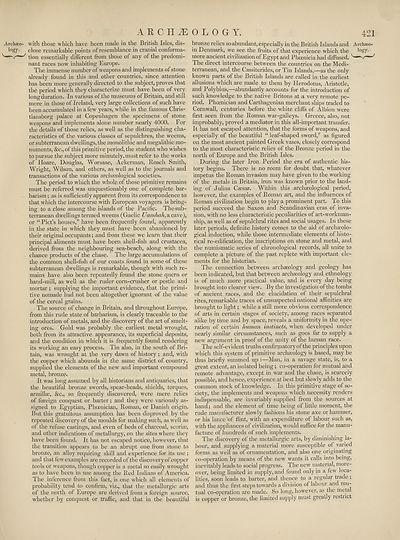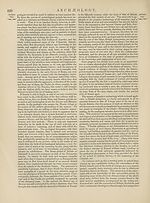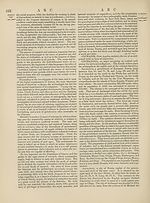Encyclopaedia Britannica > Volume 3, Anatomy-Astronomy
(429) Page 421
Download files
Complete book:
Individual page:
Thumbnail gallery: Grid view | List view

ARC H JE
Archaeo- with those which have been made in the British Isles, dis-
l°gy- close remarkable points of resemblance in cranial conforma-
^ tion essentially different from those of any of the predomi¬
nant races now inhabiting Europe.
The immense number of weapons and implements of stone
already found in this and other countries, since attention
has been more generally directed to the subject, proves that
the period which they characterize must have been of very
long duration. In various of the museums of Britain, and still
more in those of Ireland, very large collections of such have
been accumulated in a few years, while in the famous Chris-
tiansborg palace at Copenhagen the specimens of stone
weapons and implements alone number nearly 4000. For
the details of those relics, as well as the distinguishing cha¬
racteristics of the various classes of sepulchres, the weems,
or subterranean dwellings, the monolithic and megalithic mo¬
numents, &c.,of this primitive period, the student who wishes
to pursue the subject more minutely, must refer to the works
of Hoare, Douglas, Worsaae, Ackerman, Roach Smith,
Wright, Wilson, and others, as well as to the journals and
transactions of the various archaeological societies.
The period to which the whole of those primitive remains
must be referred was unquestionably one of complete bar¬
barism ; as is sufficiently apparent from its correspondence to
that which the intercourse with European voyagers is bring¬
ing to a close among the islands of the Pacific. The sub¬
terranean dwellings termed weems (Gaelic Uamhah, a cave),
or “ Piet’s houses,” have been frequently found, apparently
in the state in which they must have been abandoned by
their original occupants; and from these we learn that their
principal aliments must have been shell-fish and Crustacea,
derived from the neighbouring sea-beach, along with the
chance products of the chase. The large accumulations of
the common shell-fish of our coasts found in some of these
subterranean dwellings is remarkable, though with such re¬
mains have also been repeatedly found the stone quern or
hand-mill, as well as the ruder corn-crusher or pestle and
mortar ; supplying the important evidence, that the primi¬
tive nomade bad not been altogether ignorant of the value
of the cereal grains.
The source of change in Britain, and throughout Europe,
from this rude state of barbarism, is clearly traceable to the
introduction of metals, and the discovery of the art of smelt¬
ing ores. Gold was probably the earliest metal wrought,
both from its attractive appearance, its superficial deposits,
and the condition in which it is frequently found rendering
its working an easy process. Tin also, in the south of Bri¬
tain, was wrought at the very dawn of history ; and, with
the copper which abounds in the same district of country,
supplied the elements of the new and important compound
metal, bronze.
It was long assumed by all historians and antiquaries, that
the beautiful bronze swords, spear-heads, shields, torques,
armillae, &c., so frequently discovered, were mere relics
of foreign conquest or barter; and they were variously as¬
signed to Egyptian, Phoenician, Roman, or Danish origin.
But this gratuitous assumption has been disproved by the
repeated discovery of the moulds for making such, as well as
of the refuse castings, and even of beds of charcoal, scoria1,
and other indications of metallurgy, on the sites where they
have been found. It has not escaped notice, however, that
the transition appears to be an abrupt one from stone to
bronze, an alloy requiring skill and experience for its use;
and that few examples are recorded of the discovery of copper
tools or weapons, though copper is a metal so easily wrought
as to have been in use among the Red Indians of America.
The inference from this fact, is one which all elements of
probability tend to confirm, viz., that the metallurgic arts
of the north of Europe are derived from a foreign source,
whether by conquest or traffic, and that in the beautiful
O L O G Y. 421
bronze relics so abundant, especially in the British Islands and Archaeo-
in Denmark, we see the fruits of that experience which the logy-
more ancient civilization of Egypt and Phoenicia had diffused.
The direct intercourse between the countries on the Medi¬
terranean, and the Cassiterides, or Tin Islandsas the only
known parts of the British Islands are called in the earliest
allusions which are made to them by Herodotus, Aristotle,
and Polybius,—abundantly accounts for the introduction of
such knowledge to the native Britons at a very remote pe¬
riod. Phoenician and Carthagenian merchant ships traded to
Cornwall, centuries before the white cliffs of Albion were
first seen from the Roman war-galleys. Greece, also, not
improbably, proved a mediator in this all-important transfer.
It has not escaped attention, that the forms of weapons, and
especially of the beautiful “ leaf-shaped sword,” as figured
on the most ancient painted Greek vases, closely correspond
to the most characteristic relics of the Bronze period in the
north of Europe and the British Isles.
During the later Iron Period the era of authentic his¬
tory begins. There is no room for doubt that, whatever
impetus the Roman invasion may have given to the working
of the metals in Britain, iron was known prior to the land¬
ing of Julius Caesar. Within this archaeological period,
however, the examples of Roman art, and the influences of
Roman civilization begin to play a prominent part. To this
period succeed the Saxon and Scandinavian eras of inva¬
sion, with no less characteristic peculiarities of art-workman¬
ship, as well as of sepulchral rites and social usages. In these
later periods, definite history comes to the aid of archaeolo¬
gical induction, while those intermediate elements of histo¬
rical re-edification, the inscriptions on stone and metal, and
the numismatic series of chronological records, all unite to
complete a picture of the past replete with important ele¬
ments for the historian.
The connection between archaeology and geology has
been indicated, but that between archaeology and ethnology
is of much more practical value, and is every day being
brought into clearer view. By the investigation of the tombs
of ancient races, and the elucidation of their sepulchral
rites, remarkable traces of unsuspected national affinities are
brought to light; while a still more obvious correspondence
of arts in certain stages of society, among races separated
alike by time and by space, reveals a uniformity in the ope¬
ration of certain human instincts, when developed under
nearly similar circumstances, such as goes far to supply a
new argument in proof of the unity of the human race.
The self-evident truths confirmatory of the principles upon
which this system of primitive archaeology is based, may be
thus briefly summed up :—Man, in a savage state, is, to a
great extent, an isolated being; co-operation for mutual and
remote advantage, except in war and the chase, is scarcely
possible, and hence, experience at best but slowly adds to the
common stock of knowledge. In this primitive stage of so¬
ciety, the implements and weapons which necessity renders
indispensable, are invariably supplied from the sources at
hand; and the element of time being of little moment, the
rude manufacturer slowly fashions his stone axe or hammer,
or his lance of flint, with an expenditure of labour such as,
with the appliances of civilization, would suffice for the manu¬
facture of hundreds of such implements.
The discovery of the metallurgic arts, by diminishing la¬
bour, and supplying a material more susceptible of varied
forms as well as of ornamentation, and also one originating
co-operation by means of the new wants it calls into being,
inevitably leads to social progress. The new material, more¬
over, being limited in supply, and found only in a few loca¬
lities, soon leads to barter, and thence to a regular trade ;
and thus the first steps towards a division of labour and mu¬
tual co-operation are made. So long, however, as the metal
is copper or bronze, the limited supply must greatly restrict
Archaeo- with those which have been made in the British Isles, dis-
l°gy- close remarkable points of resemblance in cranial conforma-
^ tion essentially different from those of any of the predomi¬
nant races now inhabiting Europe.
The immense number of weapons and implements of stone
already found in this and other countries, since attention
has been more generally directed to the subject, proves that
the period which they characterize must have been of very
long duration. In various of the museums of Britain, and still
more in those of Ireland, very large collections of such have
been accumulated in a few years, while in the famous Chris-
tiansborg palace at Copenhagen the specimens of stone
weapons and implements alone number nearly 4000. For
the details of those relics, as well as the distinguishing cha¬
racteristics of the various classes of sepulchres, the weems,
or subterranean dwellings, the monolithic and megalithic mo¬
numents, &c.,of this primitive period, the student who wishes
to pursue the subject more minutely, must refer to the works
of Hoare, Douglas, Worsaae, Ackerman, Roach Smith,
Wright, Wilson, and others, as well as to the journals and
transactions of the various archaeological societies.
The period to which the whole of those primitive remains
must be referred was unquestionably one of complete bar¬
barism ; as is sufficiently apparent from its correspondence to
that which the intercourse with European voyagers is bring¬
ing to a close among the islands of the Pacific. The sub¬
terranean dwellings termed weems (Gaelic Uamhah, a cave),
or “ Piet’s houses,” have been frequently found, apparently
in the state in which they must have been abandoned by
their original occupants; and from these we learn that their
principal aliments must have been shell-fish and Crustacea,
derived from the neighbouring sea-beach, along with the
chance products of the chase. The large accumulations of
the common shell-fish of our coasts found in some of these
subterranean dwellings is remarkable, though with such re¬
mains have also been repeatedly found the stone quern or
hand-mill, as well as the ruder corn-crusher or pestle and
mortar ; supplying the important evidence, that the primi¬
tive nomade bad not been altogether ignorant of the value
of the cereal grains.
The source of change in Britain, and throughout Europe,
from this rude state of barbarism, is clearly traceable to the
introduction of metals, and the discovery of the art of smelt¬
ing ores. Gold was probably the earliest metal wrought,
both from its attractive appearance, its superficial deposits,
and the condition in which it is frequently found rendering
its working an easy process. Tin also, in the south of Bri¬
tain, was wrought at the very dawn of history ; and, with
the copper which abounds in the same district of country,
supplied the elements of the new and important compound
metal, bronze.
It was long assumed by all historians and antiquaries, that
the beautiful bronze swords, spear-heads, shields, torques,
armillae, &c., so frequently discovered, were mere relics
of foreign conquest or barter; and they were variously as¬
signed to Egyptian, Phoenician, Roman, or Danish origin.
But this gratuitous assumption has been disproved by the
repeated discovery of the moulds for making such, as well as
of the refuse castings, and even of beds of charcoal, scoria1,
and other indications of metallurgy, on the sites where they
have been found. It has not escaped notice, however, that
the transition appears to be an abrupt one from stone to
bronze, an alloy requiring skill and experience for its use;
and that few examples are recorded of the discovery of copper
tools or weapons, though copper is a metal so easily wrought
as to have been in use among the Red Indians of America.
The inference from this fact, is one which all elements of
probability tend to confirm, viz., that the metallurgic arts
of the north of Europe are derived from a foreign source,
whether by conquest or traffic, and that in the beautiful
O L O G Y. 421
bronze relics so abundant, especially in the British Islands and Archaeo-
in Denmark, we see the fruits of that experience which the logy-
more ancient civilization of Egypt and Phoenicia had diffused.
The direct intercourse between the countries on the Medi¬
terranean, and the Cassiterides, or Tin Islandsas the only
known parts of the British Islands are called in the earliest
allusions which are made to them by Herodotus, Aristotle,
and Polybius,—abundantly accounts for the introduction of
such knowledge to the native Britons at a very remote pe¬
riod. Phoenician and Carthagenian merchant ships traded to
Cornwall, centuries before the white cliffs of Albion were
first seen from the Roman war-galleys. Greece, also, not
improbably, proved a mediator in this all-important transfer.
It has not escaped attention, that the forms of weapons, and
especially of the beautiful “ leaf-shaped sword,” as figured
on the most ancient painted Greek vases, closely correspond
to the most characteristic relics of the Bronze period in the
north of Europe and the British Isles.
During the later Iron Period the era of authentic his¬
tory begins. There is no room for doubt that, whatever
impetus the Roman invasion may have given to the working
of the metals in Britain, iron was known prior to the land¬
ing of Julius Caesar. Within this archaeological period,
however, the examples of Roman art, and the influences of
Roman civilization begin to play a prominent part. To this
period succeed the Saxon and Scandinavian eras of inva¬
sion, with no less characteristic peculiarities of art-workman¬
ship, as well as of sepulchral rites and social usages. In these
later periods, definite history comes to the aid of archaeolo¬
gical induction, while those intermediate elements of histo¬
rical re-edification, the inscriptions on stone and metal, and
the numismatic series of chronological records, all unite to
complete a picture of the past replete with important ele¬
ments for the historian.
The connection between archaeology and geology has
been indicated, but that between archaeology and ethnology
is of much more practical value, and is every day being
brought into clearer view. By the investigation of the tombs
of ancient races, and the elucidation of their sepulchral
rites, remarkable traces of unsuspected national affinities are
brought to light; while a still more obvious correspondence
of arts in certain stages of society, among races separated
alike by time and by space, reveals a uniformity in the ope¬
ration of certain human instincts, when developed under
nearly similar circumstances, such as goes far to supply a
new argument in proof of the unity of the human race.
The self-evident truths confirmatory of the principles upon
which this system of primitive archaeology is based, may be
thus briefly summed up :—Man, in a savage state, is, to a
great extent, an isolated being; co-operation for mutual and
remote advantage, except in war and the chase, is scarcely
possible, and hence, experience at best but slowly adds to the
common stock of knowledge. In this primitive stage of so¬
ciety, the implements and weapons which necessity renders
indispensable, are invariably supplied from the sources at
hand; and the element of time being of little moment, the
rude manufacturer slowly fashions his stone axe or hammer,
or his lance of flint, with an expenditure of labour such as,
with the appliances of civilization, would suffice for the manu¬
facture of hundreds of such implements.
The discovery of the metallurgic arts, by diminishing la¬
bour, and supplying a material more susceptible of varied
forms as well as of ornamentation, and also one originating
co-operation by means of the new wants it calls into being,
inevitably leads to social progress. The new material, more¬
over, being limited in supply, and found only in a few loca¬
lities, soon leads to barter, and thence to a regular trade ;
and thus the first steps towards a division of labour and mu¬
tual co-operation are made. So long, however, as the metal
is copper or bronze, the limited supply must greatly restrict
Set display mode to:
![]() Universal Viewer |
Universal Viewer | ![]() Mirador |
Large image | Transcription
Mirador |
Large image | Transcription
Images and transcriptions on this page, including medium image downloads, may be used under the Creative Commons Attribution 4.0 International Licence unless otherwise stated. ![]()
| Encyclopaedia Britannica > Encyclopaedia Britannica > Volume 3, Anatomy-Astronomy > (429) Page 421 |
|---|
| Permanent URL | https://digital.nls.uk/193762925 |
|---|
| Attribution and copyright: |
|
|---|---|
| Shelfmark | EB.16 |
|---|---|
| Description | Ten editions of 'Encyclopaedia Britannica', issued from 1768-1903, in 231 volumes. Originally issued in 100 weekly parts (3 volumes) between 1768 and 1771 by publishers: Colin Macfarquhar and Andrew Bell (Edinburgh); editor: William Smellie: engraver: Andrew Bell. Expanded editions in the 19th century featured more volumes and contributions from leading experts in their fields. Managed and published in Edinburgh up to the 9th edition (25 volumes, from 1875-1889); the 10th edition (1902-1903) re-issued the 9th edition, with 11 supplementary volumes. |
|---|---|
| Additional NLS resources: |
|

